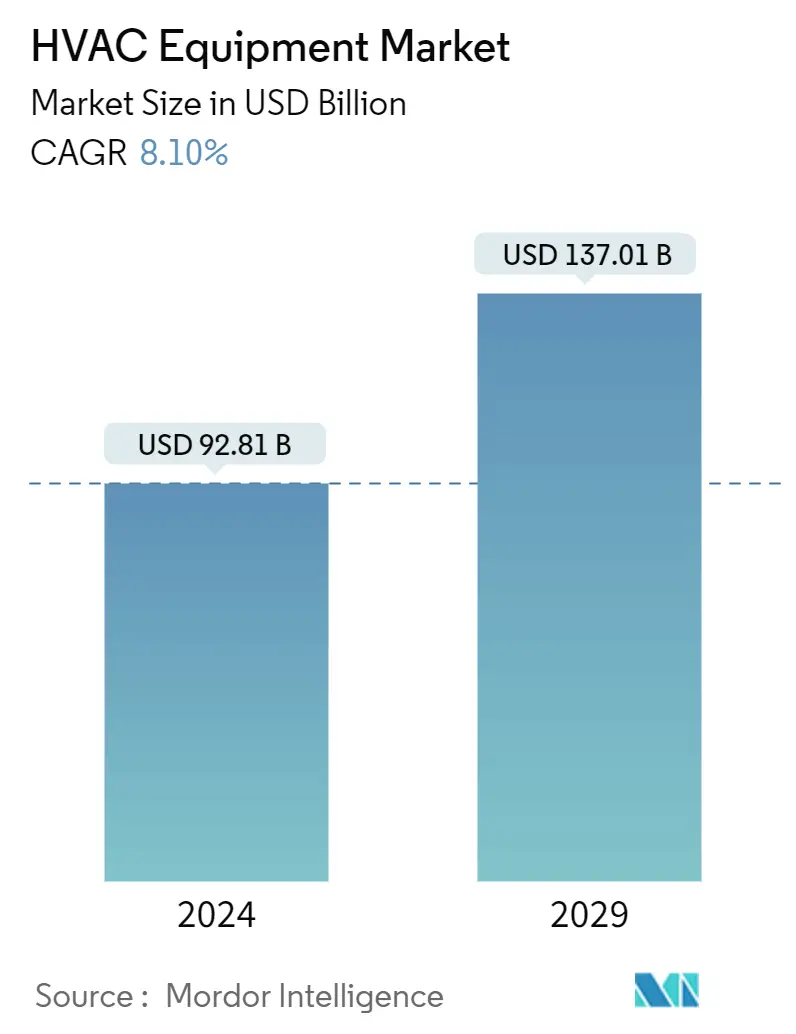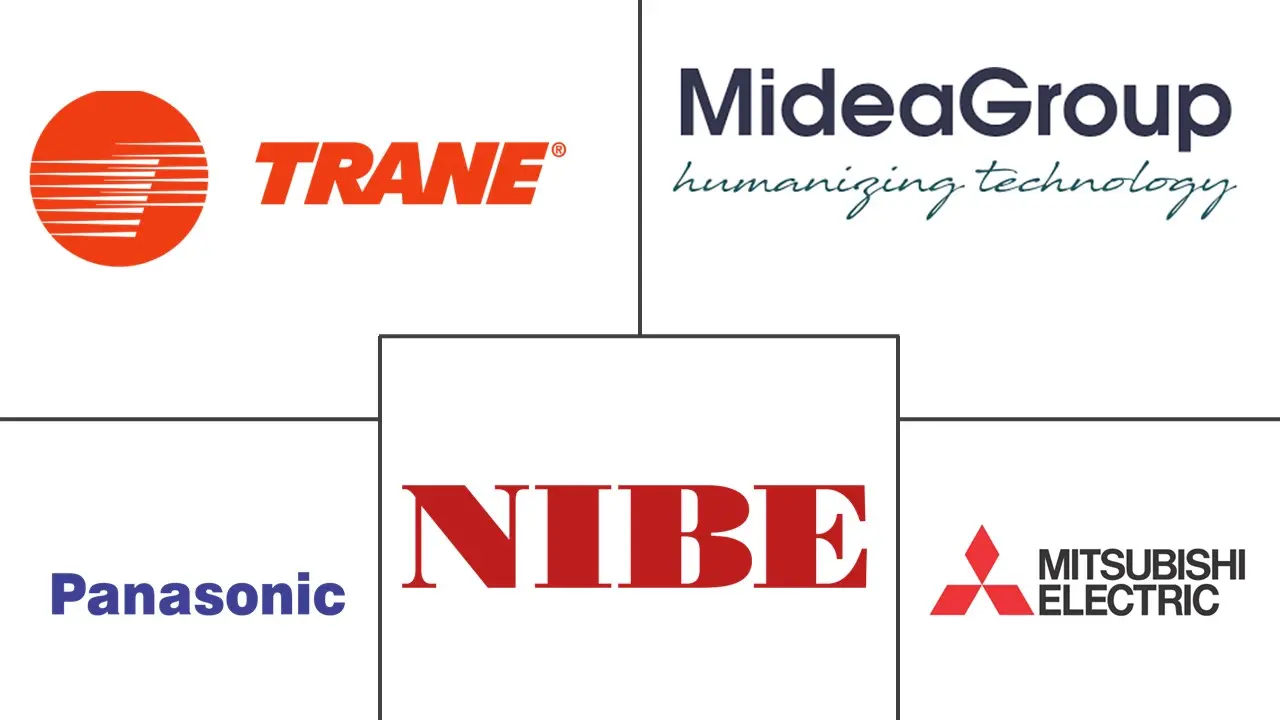Market Size of HVAC Equipment Industry

| Study Period | 2019 - 2029 |
| Market Size (2024) | USD 92.81 Billion |
| Market Size (2029) | USD 137.01 Billion |
| CAGR (2024 - 2029) | 8.10 % |
| Fastest Growing Market | Asia Pacific |
| Largest Market | Asia Pacific |
| Market Concentration | Low |
Major Players
*Disclaimer: Major Players sorted in no particular order |
HVAC Equipment Market Analysis
The HVAC Equipment Market size is estimated at USD 92.81 billion in 2024, and is expected to reach USD 137.01 billion by 2029, growing at a CAGR of 8.10% during the forecast period (2024-2029).
HVAC equipment can be applied in a wide range of locations and building types, such as shopping centers, industrial facilities, warehouses, etc., and ensures that a building has proper climate control with heating and cooling along with the necessary air pressure and air quality to make the occupants in the building comfortable and safe.
The rapid rise in industrialization and urbanization worldwide is one of the primary factors driving the market's growth. The movement of people from rural areas to live in towns and cities is one of the most significant population trends of modern times. More than half the world’s population (56.2%) lives in cities today. This trend toward greater urbanization can be seen in all regions of the world but is most pronounced in Latin America and the Caribbean, where more than 80 percent of the population now live in urban areas.
Urbanization looks set to continue to follow this upward curve, with the United Nations predicting that 68% of the global population will live in urban areas by 2050. With the increase in urban population, proper ventilation systems in buildings are useful in reducing air pollution levels, regulating temperature, and maintaining a healthy environment for urban residents. A ventilation system can help remove a build-up of pollutants, bacteria, and bad odors. It can also manage the temperature of a room to make it more comfortable and reduce the chance of mold growing.
According to the United Nations, the current world population of 7.6 billion is expected to reach 8.6 billion in 2030, 9.8 billion in 2050 and 11.2 billion in 2100. With roughly 83 million people being added to the world’s population every year, the upward trend in population size is expected to continue, even assuming that fertility levels will continue to decline.
Many governments worldwide offer tax incentives to encourage the installation of efficient HVAC (Heating, Ventilation, and Air Conditioning) equipment. This is part of a larger effort to reduce carbon emissions and mitigate the impact of climate change. By bolstering current supplies while accelerating the sustainable energy transition, the energy provisions of the Inflation Reduction Act will strengthen energy security and meaningfully reduce emissions, representing an important step toward a better future.
According to the European Commission, buildings in the European Union are responsible for around 40% of the energy consumption and 36% of greenhouse gas emissions, mainly from construction, usage, renovation, and demolition. HVAC systems account for a considerable share of energy usage in these buildings.
An HVAC is a complicated system made up of many different parts, including other factors such as the size of the home, type of HVAC system, HVAC brand, labor cost, climatic conditions, ductwork size, level of energy efficiency, come up with a high cost. Moreover, increasing focus on more advanced products, such as switching out a conventional heat pump for a geothermal heat pump, is expected to enhance the price charges associated with HVAC systems.
In the initial months of the outbreak of the COVID-19 pandemic, the HVAC market received a significant setback as many construction projects across the residential and construction sectors were halted globally, temporarily dampening the demand for HVAC equipment. However, governments worldwide highlighted the importance of a proper ventilation system to reduce the spread of the virus, which positively impacted the market's growth.
HVAC Equipment Industry Segmentation
HVAC equipment is an indoor and vehicular environment comfort technology that provides thermal comfort and acceptable indoor air quality. It is an integral part of residential structures, such as single-family homes, apartment buildings, hotels, and senior living facilities, as well as medium-to-large industrial and office buildings, such as hospitals, where safe and healthy building conditions are regulated, with respect to temperature and humidity, using fresh air from outdoors.
The HVAC equipment market is segmented by heating equipment (by product type [boilers and furnaces, heat pumps, unitary heaters], by end-user [residential, commercial, industrial, others], by geography [North America, Europe, Asia-Pacific, Rest of the World]), by ventilation equipment (by product type [air handling units, humidifiers, and dehumidifiers, air filters, fan coiling unit], by end-user [residential, commercial, industrial, others], by geography [North America, Europe, Asia-Pacific, rest of the World]) and by air condition equipment (by product type [unitary air conditioners [ducted splits, ductless mini splits, indoor packaged and roof tops], room air conditioners, packaged terminal air conditioners, chillers], by end user [residential, commercial, industrial, others], by geography [North America, Europe, Asia-Pacific, rest of the World]). The report offers market forecasts and size in value (USD) for all the above segments.
| By Heating Equipment | ||||||
| ||||||
| ||||||
|
| By Ventilation Equipment | ||||||
| ||||||
| ||||||
|
| By Air Conditioning Equipment | ||||||||||
| ||||||||||
| ||||||||||
|
HVAC Equipment Market Size Summary
The HVAC equipment market is poised for significant growth, driven by the increasing demand for efficient climate control systems across various building types, including shopping centers, industrial facilities, and warehouses. This growth is largely fueled by the rapid urbanization and industrialization trends observed globally, with a notable shift of populations from rural to urban areas. As urban populations continue to rise, the need for effective ventilation systems becomes critical to managing air quality and temperature, thereby ensuring a healthy living environment. Government initiatives worldwide, such as tax incentives and subsidies, are further propelling the adoption of energy-efficient HVAC systems, aligning with broader efforts to reduce carbon emissions and combat climate change.
The market is characterized by a diverse range of players, including major companies like Trane Inc., Midea Group, NIBE Group, Panasonic Corporation, and Mitsubishi Electric Corporation, who are actively engaging in strategic partnerships and acquisitions to enhance their product offerings. Technological advancements, such as Mitsubishi Electric's innovative heat exchanger design and Daikin Europe's new line of heat pumps, underscore the industry's focus on improving energy efficiency and reducing environmental impact. The Asia-Pacific region, particularly China and India, is expected to witness substantial growth due to increasing urbanization, rising disposable incomes, and government-led initiatives to transition towards cleaner heating alternatives. As the demand for HVAC equipment continues to rise, the market is set to expand, driven by the dual imperatives of energy efficiency and sustainability.
HVAC Equipment Market Size - Table of Contents
-
1. MARKET INSIGHTS
-
1.1 Market Overview
-
1.2 Industry Attractiveness - Porter's Five Forces Analysis
-
1.2.1 Bargaining Power of Suppliers
-
1.2.2 Bargaining Power of Buyers
-
1.2.3 Threat of New Entrants
-
1.2.4 Threat of Substitutes
-
1.2.5 Intensity of Competitive Rivalry
-
-
1.3 Industry Value Chain Analysis
-
1.4 Key Performance Indicators
-
-
2. MARKET SEGMENTATION
-
2.1 By Heating Equipment
-
2.1.1 By Product Type
-
2.1.1.1 Boilers and Furnaces
-
2.1.1.2 Heat Pumps
-
2.1.1.3 Unitary Heaters
-
-
2.1.2 By End-user Industry
-
2.1.2.1 Commercial
-
2.1.2.2 Residential
-
2.1.2.3 Industrial
-
2.1.2.4 Others
-
-
2.1.3 By Geography
-
2.1.3.1 North America
-
2.1.3.2 Europe
-
2.1.3.3 Asia-Pacific
-
2.1.3.4 Rest of the World
-
-
-
2.2 By Ventilation Equipment
-
2.2.1 By Type
-
2.2.1.1 Air Handling Units
-
2.2.1.2 Humidifiers and Dehumidifiers
-
2.2.1.3 Air Filters
-
2.2.1.4 Fan Coiling Units
-
-
2.2.2 By End User
-
2.2.2.1 Commercial
-
2.2.2.2 Residential
-
2.2.2.3 Industrial
-
2.2.2.4 Others
-
-
2.2.3 By Geography
-
2.2.3.1 North America
-
2.2.3.2 Europe
-
2.2.3.3 Asia-Pacific
-
2.2.3.4 Rest of the World
-
-
-
2.3 By Air Conditioning Equipment
-
2.3.1 By Product Type
-
2.3.1.1 Unitary Air Conditioners
-
2.3.1.1.1 Ducted Splits
-
2.3.1.1.2 Ductless Mini-splits
-
2.3.1.1.3 Indoor Packaged & Roof Tops
-
-
2.3.1.2 Room Air Conditioners
-
2.3.1.3 Packaged Terminal Air Conditioners
-
2.3.1.4 Chillers
-
-
2.3.2 By End User
-
2.3.2.1 Commercial
-
2.3.2.2 Residential
-
2.3.2.3 Industrial
-
2.3.2.4 Other End Users
-
-
2.3.3 By Geography
-
2.3.3.1 North America
-
2.3.3.2 Europe
-
2.3.3.3 Asia-Pacific
-
2.3.3.4 Rest of the World
-
-
-
HVAC Equipment Market Size FAQs
How big is the HVAC Equipment Market?
The HVAC Equipment Market size is expected to reach USD 92.81 billion in 2024 and grow at a CAGR of 8.10% to reach USD 137.01 billion by 2029.
What is the current HVAC Equipment Market size?
In 2024, the HVAC Equipment Market size is expected to reach USD 92.81 billion.

